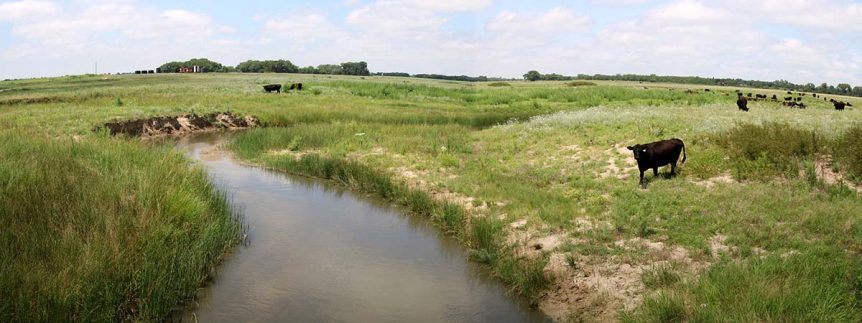Over the last couple of years, the USFWS Kansas Partners for Fish & Wildlife Program along with numerous partners have been successfully leveraging funding sources — including a NAWCA small grant and a Kansas Forest Service grant — to support the removal of invasive tamarisk and Russian olive trees in the Rattlesnake Creek Basin, which is upstream of Quivira National Wildlife Refuge (NWR). Working with Kansas Grazing Lands Coalition and Kansas Alliance for Wetlands and Streams, the Partners for Fish & Wildlife Program has restored over 600 wetland acres and 1,900 acres of associated native prairie through voluntary private landowner projects.
“Controlling Russian olive and tamarisk is a common-ground issue for agricultural producers in the Rattlesnake Creek Basin. Removing invasives not only restores wetland wildlife habitat but also increases rangeland health and forage opportunities,” explains USFWS Biologist Aron Flanders. “One livestock producer remarked that he ‘can’t believe how much grass grew after the trees were removed.’”
“Removing invasives not only restores wetland wildlife habitat but also increases rangeland health and forage opportunities.”
When Russian olive and tamarisk are removed, stream health is improved, which improves forage for cattle and provides expanses of herbaceous marshes that are very attractive to migrating waterfowl and other wetland dependent birds. Water flowing downstream to feed Quivira NWR wetlands is also enhanced, and waterfowl hunting and wildlife viewing opportunities are increased.
“These non-native trees took root in Stafford County decades ago, and their dense growth spread across the basin, negatively impacting wildlife and agriculture and influencing water flow,” explains USFWS Biologist Aron Flanders. “The NAWCA and Kansas Forest Service grants have provided a significant contribution to restoring and increasing critical wildlife habitat, improving stream health, and enhancing Quivira’s resistance to tree invasion.”
Quivira is located in a narrow section of the Central Flyway where many migratory waterbirds are funnelled on their journey north. Its unique inland marshes and alkali flats make this region an area of greatest continental significance to North American waterfowl and shorebirds and also provides critical habitat for rare species, such as the federally endangered Whooping Crane. Russian olive and tamarisk can rapidly invade wildlife areas and cause habitat loss through dense growth that displaces native plants, increases soil salinity, uses high amounts of water, and alters stream flow.
The project partners — which include Kansas Department of Wildlife and Parks, Kansas Prescribed Fire Council, The Nature Conservancy, and many others — continue to leverage existing resources to fund additional work. The second phase of the project has been included in a Kansas Prairie Wetlands Standard NAWCA proposal submitted last July.
“The USFWS Partners program is undertaking important work to maintain this RAMSAR site (Wetlands of International Importance). The wet meadow restoration maintains the Quivira wetlands and increases waterfowl habitat outside the refuge boundaries,” says Christopher Rustay, PLJV Conservation Delivery Leader. “It is a real feather in their cap to be able to not only show the benefits of invasive removal for wetland species but also for a variety of other reasons and then to capitalize on the potential funding from many of the varied interests who benefit from their work.”

